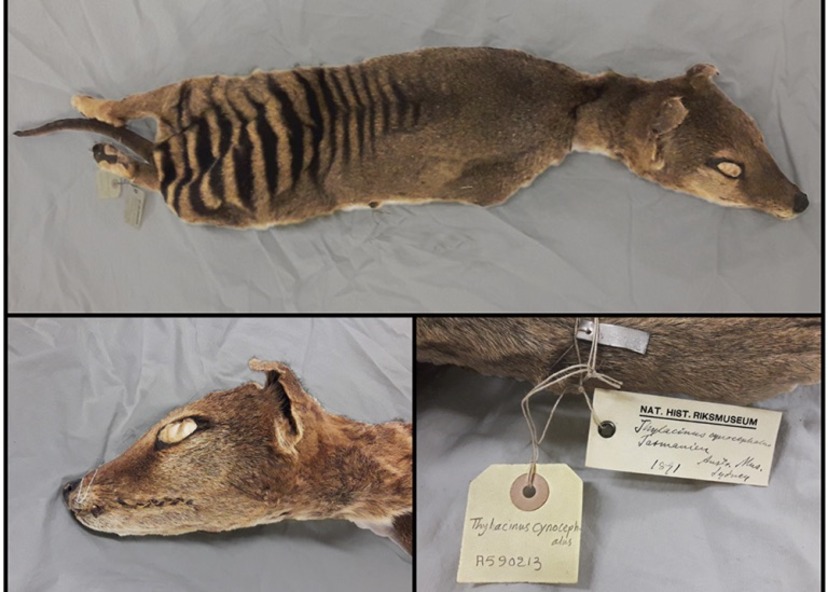
In a groundbreaking achievement, scientists have achieved a remarkable feat – the isolation and sequencing of RNA molecules from an extinct species. This pioneering endeavor involved studying a well-preserved specimen of a Tasmanian tiger, which had been dried and stored at room temperature for over a century in a museum collection. The implications of this milestone are profound, particularly for ongoing efforts to revive extinct species, including the Tasmanian tiger and the woolly mammoth.
The Tasmanian tiger, scientifically known as the marsupial thylacine, was once a carnivorous marsupial inhabiting various regions across the Australian continent and the island of Tasmania. Unfortunately, the species faced a rapid decline due to European colonization, exacerbated by the issuance of a £1 bounty for each adult thylacine killed in 1888. Tragically, the last known living Tasmanian tiger perished in captivity in 1936 at Beaumaris Zoo in Hobart, Tasmania.
Efforts to revive extinct species, especially the Tasmanian tiger, have garnered attention. With much of its natural habitat in Tasmania still relatively intact, there is hope for a potential ‘reintroduction’ of this species. The revival of such a creature could contribute to ecosystem restoration in areas disturbed by the species’ disappearance.
However, resurrecting an extinct species like the Tasmanian tiger presents formidable challenges. It necessitates in-depth knowledge not only of the species’ genome (DNA) but also of how tissue-specific genes are expressed and regulated through the study of its transcriptome (RNA).
“Reviving the Tasmanian tiger or the woolly mammoth is not easy. It will require a deep knowledge of both their genome and transcriptome regulation,” emphasizes Emilio Mármol, the first author of the study published in the journal Genome Research. The research was conducted by a collaborative effort between the Science for Life Laboratory (SciLifeLab) and the Center for Paleogenetics, which operates in conjunction with The National Museum of Natural History and Stockholm University.
In a historic first, the researchers successfully sequenced the transcriptome of skin and skeletal muscle tissues obtained from a 130-year-old desiccated Tasmanian tiger specimen preserved at room temperature at the National Museum of Natural History in Stockholm. This remarkable achievement enabled the identification of tissue-specific gene expression patterns similar to those seen in living marsupials and placental mammals.
The reconstructed transcriptomes provided such high-quality data that researchers could pinpoint RNA molecules encoding proteins specific to muscle and skin, and even identify previously undiscovered genes encoding ribosomal RNAs and microRNAs.
Marc R. Friedländer, Associate Professor at the Department of Molecular Biosciences Wenner-Gren Institute, Stockholm University and SciLifeLab, describes the significance of this breakthrough: “This is the first time that we have gained insight into the presence of regulatory genes specific to the Tasmanian tiger from an individual that died more than a century ago.”
Moreover, this study opens exciting prospects for the exploration of RNA molecules within the extensive collections of specimens and tissues housed in museums worldwide. Love Dalén, a professor of evolutionary genomics at Stockholm University and the Center for Paleogenetics, envisions the future potential to recreate RNA not just from extinct animals but also from RNA viruses like SARS-CoV-2 and their evolutionary predecessors found in museum collections, particularly in specimens from bats and other host organisms.
This remarkable breakthrough in sequencing RNA from an extinct species offers a glimpse into the genetic past and holds promise for future scientific endeavors, from conservation to virology.
RELATED ARTICLES
- Researchers Warn Vaping is just as Harmful as Cigarettes
- WEF Scientists Warn Next Pandemic Will 'Kill Billions'
- Spike Protein Makes Women 'Infertile', Scientists Warn
- Scientists Have Recreated World's Deadliest Flu Virus
- DNA test to be added to Covid screening











